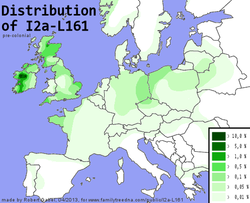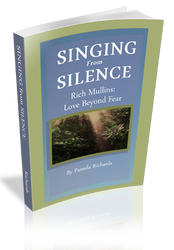Here in America, most of us have the experience of representing several mixed nationalities in our bloodlines. Yet of all the lines of ancestry he might have claimed, from French to English to Welsh to anything else, Richard Wayne Mullins consistently identified himself with Irish heritage. Yet we have discovered some surprises in his genetic roots. Which raises the question: how Irish was Richard, really? It was a question native Irishman Steve Stockman had raised in his interview about Richard on the Homeless Man documentary:
Steve Stockman: "This idea that he was Irish. I've no idea where it came from. I think it was half Irish and half everything and half about five different things, which you can't be half of, but he wanted to have a claim to it. And I'm not sure if that was his name Mullins or whether it was coming to Ireland and seeing it and falling in love with some kind of mythology of it. But certainly ‘The Color Green’ was an Irish song and the Chieftains I know influenced that, and he played the hammered dulcimer I'll bet like the Chieftains would if they'd ever seen a hammered dulcimer."
--The Homeless Man, Documentary
Was Rich Mullins a son of Ireland through his blood, or were his connections with the land and her stories merely the product of his creative genius? The most recent research on his yDNA line suggests a surprising answer to a great many questions about Richard’s Irishness, and his deep love of the legends and lore of Ireland.
I knew from our friendship that Richard was perfectly content with imperfect ancestors. I’m sure he would have agreed with biographer Jim Smith that having a King or Queen in the family line isn’t important: in fact, he didn’t hesitate to point out the flaws of his forefathers, if only to create a bond with the rest of us:
". . . Then the conversation turns to Richard's description of his ancestry. 'I've got both saints and sinners in my family line,' he announces, buttering his toast. 'I have Quakers on my mother's side, and moonshiners and counterfeiters on my father's side. My great-grandfather,' he added, 'died in Federal prison. He was in for counterfeiting. . .*’”
". . . Instead of being intimidated by Richard's genealogy that day, the rest of us were enthralled with his candor. . . I have never met anyone who used his ancestry so effectively to form bonds with his fellow man. But bonding was what Richard consistently worked to do, whether through his music, his lyrics, his honesty, his storytelling, his laughter, or his everyman approach to genealogy. . . "
--Singing from Silence, p. 44, 46
*View this page for Gary Mullins' contribution from his notes on "Andy" Mullins
Paternal DNA Test Results
When Richard died in 1997, the option to examine his genetic background did not exist. But beginning in about 2003, the new and evolving science of genetic genealogy has given us a glimpse through a widening window into our ancient past.
The latest research reveals Richard’s ancestral family, now known as I L 161, lived not only in Ireland, they also inhabited England, Scotland and Wales. Of course, these island countries were not referred to by the same names as long as 5,000 or 6,000 years ago, so we refer to this tribe as the “Isles”people. Richard's subgroup is I2a, and his specific subgroup is A, among the most ancient of Isles tribes.
Bernie Cullen, administrator for the Family Tree I haplogroup adds this note about the small surname cluster who share Richard’s ancestral line:
“In general, all three families (Mullins, Adkins, O’Driscoll) belong to the I-L161 and more specifically "Isles-A" branch. From new SNP tests (L1498 and PF4135) we know that Isles-A is not closely related to other I-L161 people in Britain/Ireland or in Europe. It seems to be a rare branch that survived only in Britain/Ireland but not on the continent, and which had a small population boom recently. Part of that population boom was part of whatever led the O'Driscolls to becoming one of the dominant families of part of Cork, and another part of the population boom was the Mullins/Adkins etc. being earliest settlers of Virginia etc. and going west.
“BritainsDNA.com calls all of I-L161 the Deer Hunters, meaning they were hunter gathers in Britain/Ireland thousands of years ago and I think that is probably right.”
In order to specifically identify the deep ancestry of Richard Wayne Mullins, we have the opinion of the foremost worldwide expert on the I halpogroup, Kenneth Nordtvedt, who was kind enough to identify the y-DNA results of Rich Mullins’ relative David Mullins, son of “Old” Booker Mullins. He offered his opinion:
“Most of Isles A, like the rest of Isles (B,C,D). . . looks like Ireland and then Scotland and then England as place of origins. I put Isles A in the British Isles five or six thousand years ago. . .”

“Isles A has an ancient Irish past . . . (and an) affiliation with the pre-gaelic celts known as the Erainn. Certainly, the Driscolls have an ancient history that claims they were 'of the Erainn.'
“Additionally, the existing accounts we have of the Erainn and other pre-gaelic celts by and large describe them as small dark people w/black hair and blue eyes. . . ”
Richard’s eyes were brown, but at 5” 6’ or 7’ with black hair, a dark complexion and a light build, the description otherwise holds.* Richard was confident of his Irish heritage during his lifetime. Now on the other side of the Jordan, he is well-acquainted with his ancestors. With all due respect, perhaps it’s only Steven Stockman who will be surprised.
*A person’s appearance is determined by autosomal DNA, which combines traits of both parents. Still, this description points out how his genetic line might differ in appearance from what Steven Stockman may have been looking for in a fellow Irishman.
The Rocks Cry Out
So how did Richard express his own sense of Irishness in his life, and in his art? Here’s one brief example of Richard’s use of Irish legend in his songwriting, with more to follow in the next post:
“And on my way to early meeting
I heard the rocks crying out
I heard the rocks crying out”
The Color Green by Rich Mullins
Most of us easily identify the allusion to Christ’s entry into Jerusalem:
“When he came near the place where the road goes down the Mount of Olives, the whole crowd of disciples began joyfully to praise God in loud voices for all the miracles they had seen:
‘Blessed is the king who comes in the name of the Lord! Peace in heaven and glory in the highest!’
Some of the Pharisees in the crowd said to Jesus, ‘Teacher, rebuke your disciples!’
‘I tell you,' he replied, 'if they keep quiet, the stones will cry out.’"
Jesus may have been referring to more than one scripture: Psalm 68:19, which describes the adoration of all creation, and/or Habbakuk 2:11, a warning to humankind against oppressing our fellow man.
Likewise, Richard may have had more than one allusion in mind when he referred to the rocks crying out in “The Color Green.” The lyric implies that God himself is the true King of Ireland by describing the coronation of ancient Irish Kings:
“. . . The third of Tara's wonders was the Lia Fail or Coronation Stone, on which the ancient kings were crowned; and the wonder of this was that it uttered a shout whenever a king of the true Scotic or Irish race stood or sat on it. And it was from this stone that Ireland received the old poetical name of Inisfail, that is, the Island of the (Lia) Fail. . .”
http://www.libraryireland.com/Wonders/Lia-Fail-1.php
This acknowledgement of the royalty of God, King of all Kings and over all nations, stands as an echo and restatement of the lyric in Here in America:
“. . . and the Holy King of Israel loves me here in America. . .”
Rich Mullins, Here in America
We may wonder whether Richard consciously included the legend of the crying stones of Tara in his song. Even if he had, he couldn’t have known that his ancestral connection to the spot would be confirmed more than a decade after his death. Yet the allusion takes on a surprising resonance when we consider that Richard’s paternal genetic tribe encompasses the ancient Kings of Tara, who also made the rocks cry out.*
*The King’s return was a repeated theme in Richard’s songs, beginning with his 1977 Cincinnati Bible College concert, In Worship of The Coming King. You can see the illustrated libretto Richard had me create for the concert here.

 RSS Feed
RSS Feed
